I like to optimize (minimize) the following given function (quad_function) by using Optim.jl with automatic differentiation (autodiff=true).
My objective function rounds Real values to whole numbers and is therefore step-like.
As I use the autodiff option, my Real values get dual numbers (ForwardDiff.Duals). But unfortunately there is no round function implemented for the ForwardDiff.Dual type. Thus I have written a roundtoint64 function, which extracts the real part. This approach causes problems during the optimization.
using Plots
plotlyjs()
function roundtoint64(x)
if typeof(x) <: ForwardDiff.Dual
roundtoint64(x.value)
else
Int64(round(x))
end
end
function quad_function(xs::Vector)
roundtoint64(xs[1])^2 + roundtoint64(xs[2])^2
end
x, y = linspace(-5, 5, 100), linspace(-5, 5, 100)
z = Surface((x,y)->quad_function([x,y]), x, y)
surface(x,y,z, linealpha = 0.3)
This is how my quad_function looks like:

The problem is, that the optimize functions converges immediately and does not proceed.
using Optim
res = Optim.optimize(
quad_function,
[5.0,5.0],
Newton(),
OptimizationOptions(
autodiff = true,
# show_trace = true
))
result:
Results of Optimization Algorithm
* Algorithm: Newton's Method
* Starting Point: [5.0,5.0]
* Minimizer: [5.0,5.0]
* Minimum: 5.000000e+01
* Iterations: 0
* Convergence: true
* |x - x'| < 1.0e-32: false
* |f(x) - f(x')| / |f(x)| < 1.0e-32: false
* |g(x)| < 1.0e-08: true
* Reached Maximum Number of Iterations: false
* Objective Function Calls: 1
* Gradient Calls: 1
optimal_values = Optim.minimizer(res) # [5.0, 5.0]
optimum = Optim.minimum(res) # 50.0
I also tried to initialize the optimize function with a vector of integers [5,5] to avoid rounding things, but that causes also problems finding the initial step size in:
ERROR: InexactError()
in alphainit(::Int64, ::Array{Int64,1}, ::Array{Int64,1}, ::Int64) at /home/sebastian/.julia/v0.5/Optim/src/linesearch/hz_linesearch.jl:63
in optimize(::Optim.TwiceDifferentiableFunction, ::Array{Int64,1}, ::Optim.Newton, ::Optim.OptimizationOptions{Void}) at /home/sebastian/.julia/v0.5/Optim/src/newton.jl:69
in optimize(::Function, ::Array{Int64,1}, ::Optim.Newton, ::Optim.OptimizationOptions{Void}) at /home/sebastian/.julia/v0.5/Optim/src/optimize.jl:169
Question: Is there a way to tell optimize to only explore the integer space?
Update:
I think the problem with the converting approach to Int64 is that I no longer have ForwardDiff.Duals and thus can't compute any derivatives/gradients. How could a better round function look like, which rounds also nested duals and gives back duals?
